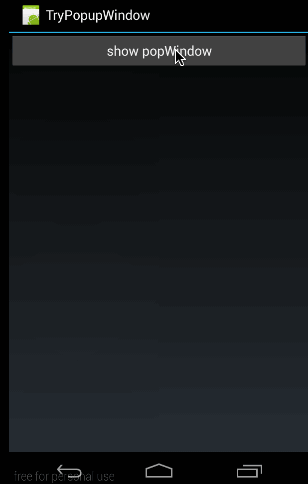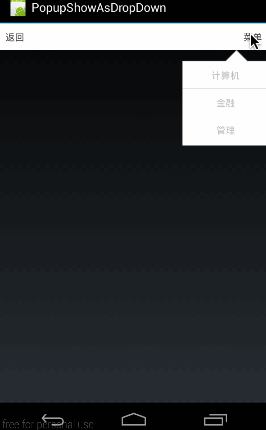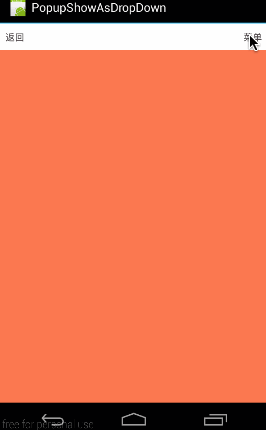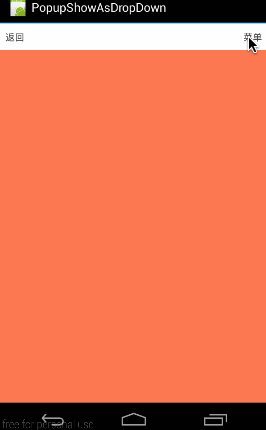本文转载自
http://blog.csdn.net/harvic880925/article/details/49272285
相关文章:
1、《PopUpWindow使用详解(一)——基本使用》
2、《PopUpWindow使用详解(二)——进阶及答疑》
有同学讲到想要知道PopUpWindow的知识,这里就给大家讲一讲PopUpWindow的基本用法和原理吧。这段时间博客可能会更新比较慢,因为你懂的 !!-_- ,往左看公告,嘿嘿。
这个效果很容易理解:当点击btn时,在底部弹出PopupWindow,然后点击各个item弹出对应toast。
一、概述
1、PopupWindow与AlertDialog的区别
最关键的区别是AlertDialog不能指定显示位置,只能默认显示在屏幕最中间(当然也可以通过设置WindowManager参数来改变位置)。而PopupWindow是可以指定显示位置的,随便哪个位置都可以,更加灵活。
有关Dialog的相关知识,大家可以参考我的系列博客:
《详解Dialog(一)——基础元素构建》
2、PopupWindow的相关函数
(1)、构造函数:
public PopupWindow (Context context) public PopupWindow(View contentView) public PopupWindow(View contentView, int width, int height) public PopupWindow(View contentView, int width, int height, boolean focusable)
首要注意:看这里有四个构造函数,但要生成一个PopupWindow最基本的三个条件是一定要设置的:View contentView,int width, int height ;少任意一个就不可能弹出来PopupWindow!!!!
所以,如果使用方法一来构造PopupWindow,那完整的构造代码应该是这样的:
View contentView = LayoutInflater.from(MainActivity. this ).inflate(R.layout.popuplayout, null ); PopupWindwo popWnd = PopupWindow (context); popWnd.setContentView(contentView); popWnd.setWidth(ViewGroup.LayoutParams.WRAP_CONTENT); popWnd.setHeight(ViewGroup.LayoutParams.WRAP_CONTENT);
有关为什么一定要设置width和height的原因,我们后面会讲,这里说一下为什么样强制设置contentView;很简单的原因是因为PopupWindow没有默认布局,它不会像AlertDialog那样只setTitle,就能弹出来一个框。PopupWindow是没有默认布局的,它的布局只有通过我们自己设置才行。由于方法三中,含有了这三个必备条件,不用单独设置contentview或者width、height,所以构造方法三是用的最多的一个构造方法。
最后,方法四中的focusable变量不是必须的,有关它的方法和意义,我们会在下一篇中细讲。
(2)显示函数
显示函数主要使用下面三个:
showAsDropDown(View anchor): showAsDropDown(View anchor, int xoff, int yoff): showAtLocation(View parent, int gravity, int x, int y):
这里有两种显示方式:
1、显示在某个指定控件的下方
showAsDropDown(View anchor):
showAsDropDown(View anchor, int xoff, int yoff);
2、指定父视图,显示在父控件的某个位置(Gravity.TOP,Gravity.RIGHT等)
showAtLocation(View parent, int gravity, int x, int y);
(3)、其它函数
public void dismiss() public void setFocusable( boolean focusable) public void setTouchable( boolean touchable) public void setOutsideTouchable( boolean touchable) public void setBackgroundDrawable(Drawable background)
这几个函数里,这篇只会用到dismiss(),用于不需要的时候,将窗体隐藏掉。
好了,废话不多说了,我们就做一个上面的例子来看一下。
二、简单示例(showAtLocation显示窗体)
在这个例子中,我们实现两个功能,弹出popupWindow和Item点击响应
1、主布局(main.xml)
从效果图中也可以看到主布局只有一个button,什么都没有,所以它的布局代码哪下:
<? xml version = "1.0" encoding = "utf-8" ?> < LinearLayout xmlns:android = "http://schemas.android.com/apk/res/android" android:orientation = "vertical" android:layout_width = "fill_parent" android:layout_height = "fill_parent" > < Button android:id = "@+id/btn" android:layout_width = "fill_parent" android:layout_height = "wrap_content" android:text = "show popWindow" /> </ LinearLayout >
2、PopupWindow布局(popuplayout.xml)
在概述中,我们提到了,必须为PopupWindow设置布局,从效果图中,我也可以看到它的布局有三个item,中间用横线分开。所以这里布局使用Listview应该更合适,但为了减轻代码难度,我们直接使用TextView和分隔线来代替,代码如下:
<? xml version = "1.0" encoding = "utf-8" ?> < LinearLayout xmlns:android = "http://schemas.android.com/apk/res/android" android:layout_width = "fill_parent" android:layout_height = "wrap_content" android:background = "#ffffff" android:orientation = "vertical" android:paddingBottom = "2dp" > < View android:layout_width = "match_parent" android:layout_height = "2.25dp" android:background = "#fa7829" android:layout_alignParentTop = "true" /> < TextView android:id = "@+id/pop_computer" android:layout_width = "match_parent" android:layout_height = "wrap_content" style = "@style/pop_text_style" android:text = "计算机" /> < View android:layout_width = "match_parent" android:layout_height = "1dp" android:background = "@drawable/list_line" /> < TextView android:id = "@+id/pop_financial" android:layout_width = "match_parent" android:layout_height = "wrap_content" style = "@style/pop_text_style" android:text = "金融" /> < View android:layout_width = "match_parent" android:layout_height = "1dp" android:background = "@drawable/list_line" /> < TextView android:id = "@+id/pop_manage" android:layout_width = "match_parent" android:layout_height = "wrap_content" style = "@style/pop_text_style" android:text = "管理" /> < View android:layout_width = "match_parent" android:layout_height = "1dp" /> </ LinearLayout >
3、MainActivity代码
先贴出来完整代码,然后再逐步讲解:
public class MainActivity extends Activity implements View.OnClickListener{ private PopupWindow mPopWindow; @Override public void onCreate(Bundle savedInstanceState) { super .onCreate(savedInstanceState); setContentView(R.layout.main); Button btn = (Button) findViewById(R.id.btn); btn.setOnClickListener(new View.OnClickListener() { @Override public void onClick(View v) { showPopupWindow(); } }); } private void showPopupWindow() { View contentView = LayoutInflater.from(MainActivity.this ).inflate(R.layout.popuplayout, null ); mPopWindow = new PopupWindow(contentView, LayoutParams.WRAP_CONTENT, LayoutParams.WRAP_CONTENT, true ); mPopWindow.setContentView(contentView); TextView tv1 = (TextView)contentView.findViewById(R.id.pop_computer); TextView tv2 = (TextView)contentView.findViewById(R.id.pop_financial); TextView tv3 = (TextView)contentView.findViewById(R.id.pop_manage); tv1.setOnClickListener(this ); tv2.setOnClickListener(this ); tv3.setOnClickListener(this ); View rootview = LayoutInflater.from(MainActivity.this ).inflate(R.layout.main, null ); mPopWindow.showAtLocation(rootview, Gravity.BOTTOM, 0 , 0 ); } @Override public void onClick(View v) { int id = v.getId(); switch (id){ case R.id.pop_computer:{ Toast.makeText(this , "clicked computer" ,Toast.LENGTH_SHORT).show(); mPopWindow.dismiss(); } break ; case R.id.pop_financial:{ Toast.makeText(this , "clicked financial" ,Toast.LENGTH_SHORT).show(); mPopWindow.dismiss(); } break ; case R.id.pop_manage:{ Toast.makeText(this , "clicked manage" ,Toast.LENGTH_SHORT).show(); mPopWindow.dismiss(); } break ; } } }
(1)首先看OnCreate()
在OnCreate()中只做了一个操作,当点击Button时,显示窗体:
public void onCreate(Bundle savedInstanceState) { super .onCreate(savedInstanceState); setContentView(R.layout.main); Button btn = (Button) findViewById(R.id.btn); btn.setOnClickListener(new View.OnClickListener() { @Override public void onClick(View v) { showPopupWindow(); } }); }
(2)、显示PopupWindow
下面是有关窗体操作的代码:
private void showPopupWindow() { View contentView = LayoutInflater.from(MainActivity.this ).inflate(R.layout.popuplayout, null ); mPopWindow = new PopupWindow(contentView, LayoutParams.WRAP_CONTENT, LayoutParams.WRAP_CONTENT, true ); TextView tv1 = (TextView)contentView.findViewById(R.id.pop_computer); TextView tv2 = (TextView)contentView.findViewById(R.id.pop_financial); TextView tv3 = (TextView)contentView.findViewById(R.id.pop_manage); tv1.setOnClickListener(this ); tv2.setOnClickListener(this ); tv3.setOnClickListener(this ); View rootview = LayoutInflater.from(MainActivity.this ).inflate(R.layout.main, null ); mPopWindow.showAtLocation(rootview, Gravity.BOTTOM, 0 , 0 ); }
这里同样分为三部分:
第一部分:设置ContentView
View contentView = LayoutInflater.from(MainActivity. this ).inflate(R.layout.popuplayout, null ); mPopWindow = new PopupWindow(contentView,LayoutParams.WRAP_CONTENT, LayoutParams.WRAP_CONTENT, true );
利用LayoutInflater获取R.layout.popuplayout对应的View,然后利用我们上面所讲的构造函数三来生成mPopWindow;
这里 要注意一个问题:在这个构造函数里,我们传进去了width和height全部都是WRAP_CONTENT;而在R.layout.popuplayou的根布局中,我们定义的width和height代码是:layout_width="fill_parent",layout_height="wrap_content";原代码如下:
<? xml version = "1.0" encoding = "utf-8" ?> < LinearLayout xmlns:android = "http://schemas.android.com/apk/res/android" android:layout_width = "fill_parent" android:layout_height = "wrap_content" android:background = "#ffffff" android:orientation = "vertical" android:paddingBottom = "2dp" > ……………… </ LinearLayout >
这里就有冲突了,那显示出来的popupWindow是按哪个来的呢?
从效果图中来看,明显PopupWindow宽度并没有全屏,显然是按代码中的布局为准。
这说明了:
**如果在代码中重新设置了popupWindow的宽和高,那就以代码中所设置为准。**(至于原因,下篇会讲)
第二部分:设置各个控件的点击响应
TextView tv1 = (TextView)contentView.findViewById(R.id.pop_computer); TextView tv2 = (TextView)contentView.findViewById(R.id.pop_financial); TextView tv3 = (TextView)contentView.findViewById(R.id.pop_manage); tv1.setOnClickListener(this ); tv2.setOnClickListener(this ); tv3.setOnClickListener(this );
这部分没什么好讲了,设置PopupWindow中各个控件的点击响应,但一定要注意的是,PopupWindow中各个控件的所在的布局是contentView,而不是在Activity中,如果大家直接使用
TextView tv1 = (TextView)findViewById(R.id.pop_computer);
肯定会报错,因为R.id.pop_computer这个ID值在当前Activtiy的布局文件中是找不到的。只有在R.layout.popuplayout的布局文件中才会有!所以,这就是为什么,要在findViewById(R.id.pop_computer)前指定contentView的原因!!!在实际项目中,很容易遇到像这种需要指定根布局的情况,大家需要注意。
有关响应,就没什么好讲的了,因为我们在类顶部派生了View.OnClickListener,所以在OnClick函数中,直接处理即可,代码如下:(在点击不同的Item时,一边弹出不同的toast,一边将PopupWindow隐藏掉)
@Override public void onClick(View v) { int id = v.getId(); switch (id){ case R.id.pop_computer:{ Toast.makeText(this , "clicked computer" ,Toast.LENGTH_SHORT).show(); mPopWindow.dismiss(); } break ; case R.id.pop_financial:{ Toast.makeText(this , "clicked financial" ,Toast.LENGTH_SHORT).show(); mPopWindow.dismiss(); } break ; case R.id.pop_manage:{ Toast.makeText(this , "clicked manage" ,Toast.LENGTH_SHORT).show(); mPopWindow.dismiss(); } break ; } }
第三部分:showAtLocation显示窗体
View rootview = LayoutInflater.from(MainActivity. this ).inflate(R.layout.main, null ); mPopWindow.showAtLocation(rootview, Gravity.BOTTOM, 0 , 0 );
showAtLocation的显示就将PopupWindow的实例放在一个父容器中,然后指定显示在父容器中的位置。
由于,我们要将mPopWindow放在整个屏幕的最低部,所以我们将R.layout.main做为它的父容器。将其显示在BOTTOM的位置。
到这里,有关PopupWindow的显示及其中控件响应基本都讲完了,下面,我们就讲讲showAsDropDown显示窗体的用法。
源码在文章底部给出
三、另一示例(showAsDropDown显示窗体)
大家先看下面这个效果图:
这个效果图演示的是,在点击标题栏右方的“菜单”按钮时,在其下方显示一个自定义的菜单列表。
1、同样,我们先看看主布局代码(main.xml)
<? xml version = "1.0" encoding = "utf-8" ?> < LinearLayout xmlns:android = "http://schemas.android.com/apk/res/android" android:orientation = "vertical" android:layout_width = "fill_parent" android:layout_height = "fill_parent" > < RelativeLayout android:layout_width = "fill_parent" android:layout_height = "wrap_content" android:background = "#ffffff" > < TextView android:layout_width = "wrap_content" android:layout_height = "wrap_content" android:layout_alignParentLeft = "true" android:textColor = "#50484b" android:padding = "10dp" android:text = "返回" /> < TextView android:id = "@+id/menu" android:layout_width = "wrap_content" android:layout_height = "wrap_content" android:layout_alignParentRight = "true" android:textColor = "#50484b" android:padding = "10dp" android:text = "菜单" /> </ RelativeLayout > </ LinearLayout >
这段代码的布局很简单,就是生成一个标题栏,上面有两个按钮,“返回”和“菜单”
2、PopupWindow布局代码(popuplayout.xml)
这部分布局也不难,只得利用纯代码硬生成一个列表的布局。在实际项目中,大家应该使用listview来动态生成列表,这样生成的popupWindow就是可以复用的了。有关布局就不再多讲,跟上面的布局基本一样,只是换了背景。
<? xml version = "1.0" encoding = "utf-8" ?> < LinearLayout xmlns:android = "http://schemas.android.com/apk/res/android" android:layout_width = "fill_parent" android:layout_height = "wrap_content" android:background = "@drawable/pop_bg" android:orientation = "vertical" android:paddingBottom = "2dp" > < TextView android:id = "@+id/pop_computer" android:layout_width = "wrap_content" android:layout_height = "wrap_content" style = "@style/pop_text_style" android:text = "计算机" /> < View android:layout_width = "match_parent" android:layout_height = "1dp" android:background = "@drawable/list_line" /> < TextView android:id = "@+id/pop_financial" android:layout_width = "wrap_content" android:layout_height = "wrap_content" style = "@style/pop_text_style" android:text = "金融" /> < View android:layout_width = "match_parent" android:layout_height = "1dp" android:background = "@drawable/list_line" /> < TextView android:id = "@+id/pop_manage" android:layout_width = "wrap_content" android:layout_height = "wrap_content" style = "@style/pop_text_style" android:text = "管理" /> < View android:layout_width = "match_parent" android:layout_height = "1dp" /> </ LinearLayout >
3、MainActivity代码
同样是先贴出来完整代码,然后再细讲。
public class MainActivity extends Activity implements View.OnClickListener{ private PopupWindow mPopWindow; private TextView mMenuTv; @Override public void onCreate(Bundle savedInstanceState) { super.onCreate(savedInstanceState); setContentView(R.layout.main); mMenuTv = (TextView)findViewById(R.id.menu); mMenuTv.setOnClickListener(new View.OnClickListener() { @Override public void onClick(View v) { showPopupWindow(); } }); } private void showPopupWindow() { View contentView = LayoutInflater .from(MainActivity.this).inflate(R.layout.popuplayout, null); mPopWindow = new PopupWindow(contentView); mPopWindow.setWidth(ViewGroup.LayoutParams.WRAP_CONTENT); mPopWindow.setHeight(ViewGroup.LayoutParams.WRAP_CONTENT); TextView tv1 = (TextView)contentView.findViewById(R.id.pop_computer); TextView tv2 = (TextView)contentView.findViewById(R.id.pop_financial); TextView tv3 = (TextView)contentView.findViewById(R.id.pop_manage); tv1.setOnClickListener(this); tv2.setOnClickListener(this); tv3.setOnClickListener(this); mPopWindow.showAsDropDown(mMenuTv); } @Override public void onClick(View v) { int id = v .getId(); switch (id){ case R.id.pop_computer:{ Toast.makeText(this, "clicked computer", Toast.LENGTH_SHORT).show(); mPopWindow.dismiss(); } break; case R.id.pop_financial:{ Toast.makeText(this,"clicked financial",Toast.LENGTH_SHORT).show(); mPopWindow.dismiss(); } break; case R.id.pop_manage:{ Toast.makeText(this,"clicked manage",Toast.LENGTH_SHORT).show(); mPopWindow.dismiss(); } break; } } }
这段代码的意义就是点击menu弹出popupwindow,然后对各个item进行响应,我们主要讲讲showPopupWindow() 这部分,对于item响应的部分与上个示例都一样,就不再细讲。
private void showPopupWindow() { View contentView = LayoutInflater .from(MainActivity.this).inflate(R.layout.popuplayout, null); mPopWindow = new PopupWindow(contentView); mPopWindow.setWidth(ViewGroup.LayoutParams.WRAP_CONTENT); mPopWindow.setHeight(ViewGroup.LayoutParams.WRAP_CONTENT); TextView tv1 = (TextView)contentView.findViewById(R.id.pop_computer); TextView tv2 = (TextView)contentView.findViewById(R.id.pop_financial); TextView tv3 = (TextView)contentView.findViewById(R.id.pop_manage); tv1.setOnClickListener(this); tv2.setOnClickListener(this); tv3.setOnClickListener(this); mPopWindow.showAsDropDown(mMenuTv); }
这里首先注意的一个地方,在这个示例中,我们是使用的构造方法二来生成的PopupWindow实例的,同样,再强调一遍:contentView,Width,Height这三个元素是必须设置的,缺一不可!至于为什么要显式设置Width,Height,我们下篇会讲到。
View contentView = LayoutInflater.from(MainActivity. this ).inflate(R.layout.popuplayout, null ); mPopWindow = new PopupWindow(contentView); mPopWindow.setWidth(ViewGroup.LayoutParams.WRAP_CONTENT); mPopWindow.setHeight(ViewGroup.LayoutParams.WRAP_CONTENT);
然后就是使用showAsDropDown()显示PopupWindow:
mPopWindow.showAsDropDown(mMenuTv);
大家也现样可以使用showAsDropDown(View anchor, int xoff, int yoff):来添加相对x轴和y轴的位移量。具体用法就不再细讲,没什么难度,大家试一试即可。
好了,这部分示例也讲完了,下面我们就在这个示例上升级一个功能:讲讲怎么在弹出PopupWindow的同时利用阴影把背景全部给遮罩起来。
源码在文章底部给出
四、提高:为菜单添加阴影
这部分的效果图是下面这样的:
从效果图中可以看出,这部分是上一个示例的升级版,就是在点出PopupWindow的同时,把背景用半透明黑色遮罩住,像弹出AlertDialog一样的效果。下面就来看看这个效果是怎么实现的吧。
1、PopupWindow布局(popuplayout.xml)
其实原理很简单,使PopupWindow的界面充满全屏,而实际的列表菜单只是其中的一个子布局即可,所以此时的PopupWindow的布局代码如下:
<? xml version = "1.0" encoding = "utf-8" ?> < RelativeLayout xmlns:android = "http://schemas.android.com/apk/res/android" android:layout_width = "fill_parent" android:layout_height = "fill_parent" android:background = "#66000000" > < LinearLayout android:layout_width = "wrap_content" android:layout_height = "wrap_content" android:background = "@drawable/pop_bg" android:orientation = "vertical" android:paddingBottom = "2dp" android:layout_alignParentRight = "true" > < TextView android:id = "@+id/pop_computer" android:layout_width = "wrap_content" android:layout_height = "wrap_content" style = "@style/pop_text_style" android:text = "计算机" /> < View android:layout_width = "match_parent" android:layout_height = "1dp" android:background = "@drawable/list_line" /> < TextView android:id = "@+id/pop_financial" android:layout_width = "wrap_content" android:layout_height = "wrap_content" style = "@style/pop_text_style" android:text = "金融" /> < View android:layout_width = "match_parent" android:layout_height = "1dp" android:background = "@drawable/list_line" /> < TextView android:id = "@+id/pop_manage" android:layout_width = "wrap_content" android:layout_height = "wrap_content" style = "@style/pop_text_style" android:text = "管理" /> < View android:layout_width = "match_parent" android:layout_height = "1dp" /> </ LinearLayout > </ RelativeLayout >
可见在列表项外面又包了一层RelativeLayout,将列表的根布局LinearLayout靠父窗口右边显示即可。给RelativeLayout添加了半透明背景android:background="#66000000"
这样要非常注意的是,根布局RelativeLayout设置的android:layout_width和android:layout_height是无意义的,因为我们会通过代码重新设置:
private void showPopupWindow() { View contentView = LayoutInflater .from(MainActivity.this).inflate(R.layout.popuplayout, null); mPopWindow = new PopupWindow(contentView); mPopWindow.setWidth(ViewGroup.LayoutParams.FILL_PARENT); mPopWindow.setHeight(ViewGroup.LayoutParams.FILL_PARENT); ………………//设置各控件点击响应 mPopWindow.showAsDropDown(mMenuTv); }
在这里,我们通过代码将PopupWindow的width和height设置为LayoutParams.FILL_PARENT。那大家可能会有疑问:为什么我在xml中布局中明明写好了根布局RelativeLayout的宽和高,为什么非要我们在代码中重新设置呢?不设置还显示不出来…………
下篇,我们将会解答这个问题。
好啦,这个示例关键部分讲完了,其它的大家就看源码吧。
源码在文章底部给出
五、为PopupWindow添加动画
先看看效果:
为PopupWindow添加动画并不难,只需要使用一个函数即可:
mPopWindow.setAnimationStyle(R.style.contextMenuAnim);
下面就来看看具体是如何添加动画的
1、生成动画对应的style
(1)、进入时的动画:(context_menu_enter.xml)
<? xml version = "1.0" encoding = "utf-8" ?> < set xmlns:android = "http://schemas.android.com/apk/res/android" > < translate android:duration = "@android:integer/config_shortAnimTime" android:fromXDelta = "0" android:fromYDelta = "100%p" android:interpolator = "@android:anim/accelerate_decelerate_interpolator" android:toXDelta = "0" android:toYDelta = "0" /> </ set >
这段代码的意义就是从底部进入,即从Y轴100%的位置移动到0的位置。有关动画的知识,大家可以参考
《Animation 动画详解(一)——alpha、scale、translate、rotate、set的xml属性及用法》
这个系列文章。
(2)、退出时动画(context_menu_exit.xml)
<? xml version = "1.0" encoding = "utf-8" ?> < set xmlns:android = "http://schemas.android.com/apk/res/android" > < translate android:duration = "@android:integer/config_shortAnimTime" android:fromXDelta = "0" android:fromYDelta = "0" android:interpolator = "@android:anim/accelerate_decelerate_interpolator" android:toXDelta = "0" android:toYDelta = "100%p" /> </ set >
效果是从上向下移动。
(3)、最后,生成对应的style---contextMenuAnim
< style name = "contextMenuAnim" parent = "@android:style/Animation.Activity" > < item name = "android:windowEnterAnimation" > @anim/context_menu_enter </ item > < item name = "android:windowExitAnimation" > @anim/context_menu_exit </ item > </ style >
android:windowEnterAnimation设置进场动画,android:windowExitAnimation设置出场动画。
2、使用AnimationStyle
使用时非常简单,直接将对应的style通过setAnimationStyle设置进PopupWindow实例即可,代码如下,难度不大,不再细讲。
private void showPopupWindow() { View contentView = LayoutInflater .from(MainActivity.this).inflate(R.layout.popuplayout, null); mPopWindow = new PopupWindow(contentView); mPopWindow.setWidth(ViewGroup.LayoutParams.FILL_PARENT); mPopWindow.setHeight(ViewGroup.LayoutParams.FILL_PARENT); ………………//设置各子项点击响应 mPopWindow.setAnimationStyle(R.style.contextMenuAnim); mPopWindow.showAsDropDown(mMenuTv); }
到这里,这个示例的代码就讲完了。源码在文章底部一起给出。这篇讲述了有关PopupWindow的基本使用方法,下篇将针对还未讲述的几个函数,以及问题点结合源码深入剖析。
源码内容:
1、《PopshowAtLocation》:第二部分:简单示例(showAtLocation显示窗体)对应源码
2、《PopupShowAsDropDown》:第三部分:另一示例(showAsDropDown显示窗体) 对应源码
3、《PopDropDownBg》:第四部分:提高:为菜单添加阴影 对应源码
4、《PopupAnim》:第五部分:为PopupWindow添加动画 对应源码
如果本文有帮到你,记得加关注哦
源码下载地址:http://download.csdn.net/detail/harvic880925/9195255
请大家尊重原创者版权,转载请标明出处:http://blog.csdn.net/harvic880925/article/details/49272285 谢谢



























 8万+
8万+

 被折叠的 条评论
为什么被折叠?
被折叠的 条评论
为什么被折叠?








